Marulanda J.M. (ed.) Electronic Properties of Carbon Nanotubes
Подождите немного. Документ загружается.

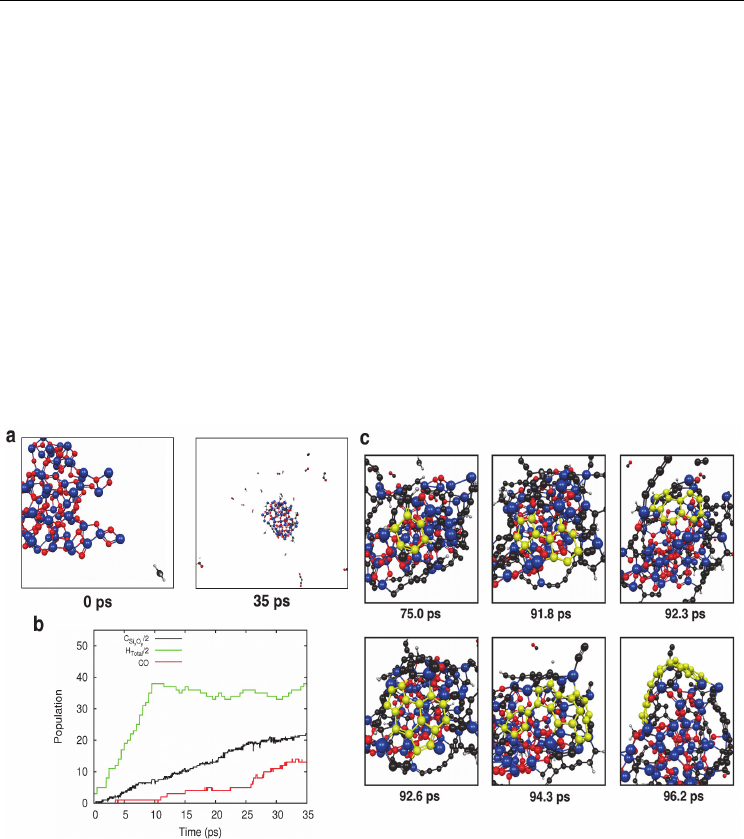
Mechanisms of Single-Walled Carbon Nanotube Nucleation,
Growth and Chirality-Control: Insights from QM/MD Simulations
535
successful in this respect. Yet it has only been since 2011 that the atomistic mechanisms of
SiO
2
-, SiC- and Si-catalysed SWNT nucleation have been established. These QM/MD
investigations will be the focus of this section.
QM/MD simulations of methane CVD on SiO
2
nanoparticles at 1200 K (Page et al., 2011b) is
outlined in Fig. 8. Due to the inherently low catalytic activity of SiO
2
itself, CH
x
radicals (x =
0 – 3 and is chosen randomly) were supplied to the SiO
2
instead of CH
4
. This approach was
motivated by the prior conclusion that CH
4
decomposes pyrolitically prior to adsorption on
the SiO
2
surface (Liu et al., 2009b). In contrast to CVD using traditional transition-metal
catalysts, a complex chemical process was observed on SiO
2
. Most notably, CO was
produced as the primary chemical product via the carbothermal reduction of the SiO
2
nanoparticle, a fact that is consistent with recent experimental observations (Bachmatiuk et
al., 2009). The production of each CO molecule first required hydrogen-abstraction from
neighboring C, Si or O atoms. Ultimately, the insertion of carbon into/removal of oxygen
from the SiO
2
nanoparticle resulted in the local formation of amorphous SiC. However, this
carbothermal reduction was limited to the outer regions of the catalyst, with the core of the
particle remaining ‘oxygen rich’. The amorphous SiC regions were composed
predominantly of extended polyyne chains ‘anchored’ in place by native Si atoms.
Fig. 8. CH
4
CVD on SiO
2
nanoparticles at 1200 K leads to SWNT nucleation via a VSS
mechanism. a) Snapshots at 0 and 35 ps showing the CVD process. b) CO is the major
chemical product of the CH
4
CVD process. The production of CO first requires the natural
removal of H from the CO carbon atom. C
SixOy
and H
SixOy
are the concentration of C and H
on the SiO
2
nanoparticle, respectively. c) Evolution of SWNT nucleation on SiO
2
nanoparticles. Contrary to nucleation on transition-metal catalysts, nucleation here requires
the saturation of the solid-phase catalyst with carbon. Blue, red and black spheres represent
Si, O and C, respectively. Yellow spheres represent C atoms involved in SWNT nucleation.
(Adapted from (Page et al., 2011b). Reprinted with permission. © 2011 American Chemical
Society)

Electronic Properties of Carbon Nanotubes
536
Consequently, these polyyne chains exhibit restricted vibrational and translational mobility,
compared to the equivalent precursor structures observed during transition-metal catalysed
SWNT nucleation. A more detailed discussion of the thermodynamic reasons underpinning
these phenomena is given below. At high concentrations of surface polyyne chains SWNT
nucleation was observed. This observation supports the previous claim by Homma and co-
workers that SWNT nucleation on solid, covalent catalysts requires a ‘carbon-covered’
catalyst nanoparticle in order for nucleation to take place (Homma et al., 2009). The
pentagonal-ring-first mechanism, established by QM/MD simulations and discussed in
§3.1-3.3, therefore played no role in the current context. Similarly, the liquid carbide phase
that is central to the VLS mechanism of SWNT, discussed in §3.3, is absent in the case of
SiO
2
-catalysed SWNT nucleation. This conclusion followed an analysis of the instantaneous
Lindemann index (Lindemann, 1910) of the SiO
2
nanoparticle during the CVD process. At
all times, the Lindemann index revealed that the SiO
2
nanoparticle existed as a solid phase
structure. Moreover, QM/MD relaxation of this nanoparticle at elevated temperatures (up
to 3000 K) indicated that nanoparticle SiO
2
decomposes from the solid phase at sufficiently
high temperatures (Page et al., 2011a). This sublimative phenomenon here rules out the VLS
mechanism as an explanation of SiO
2
-catalysed SWNT nucleation and growth entirely.
Instead, QM/MD simulations point to a vapor-solid-solid (VSS) mechanism explaining
SWNT nucleation and growth in this case. The mechanisms of SWNT nucleation and
growth on traditional and non-traditional catalysts are therefore of fundamentally different
natures. Subsequent experimental results (Liu et al., 2011) have since corroborated this
proposed VSS mechanism.
The observation that the catalytically relevant region of the SiO
2
nanoparticle is effectively
devoid of oxygen motivated the subsequent QM/MD investigation of SWNT nucleation on
pure Si nanoparticles. To this end, a Si
58
nanoparticle of approximate dimension 0.9 0.9
0.9 nm
3
was employed as a CVD catalyst at 1200 and 1800 K. Gas-phase C
2
moieties were
adsorbed on the surface of this catalyst nanoparticle in the manner described in §3.2. Two
different concentrations of carbon, viz. 30 and 100, were employed here, following the
observation made regarding the dependence of SWNT nucleation on surface carbon
concentration using SiO
2
catalyst nanoparticles. The structures of these Si
58
C
60
and Si
58
C
200
model systems, following 100 and 45 ps, are given in Fig. 9. Upon adsorption on the Si
58
surface, these C
2
moieties generally coalesced, forming extended polyyne chains, in an
identical fashion to nucleation on Fe, Ni and SiO
2
catalysts. However, the mobility of these
polyyne chains in the case of Si
58
was notably restricted, as was observed in the case of SiO
2
.
This was also the case at a higher annealing temperature of 1800 K, leading to the conclusion
that the effect of temperature (at least below 2000 K) on this SWNT nucleation process was
effectively negligible. It was noted that this was not the case at even higher temperatures, as
will be discussed below in the context of SWNT nucleation from SiC. Once formed, these
polyyne chains themselves gradually coalesced on the nanoparticle surface, ultimately
forming extended branched carbon networks. While this is consistent with the initial steps
in SWNT nucleation discussed in §3.1-3.3 in an atomistic sense, it is noted that the kinetics of
this coalescence on Si
58
is significantly slower, compared to traditional, transition metal
catalysts. In particular, in the latter case the rate-limiting step of SWNT nucleation may be
considered to be the formation of the SWNT ‘nucleus’ (the initial polygonal carbon ring
structure). Following the formation of this structure, the subsequent ring condensation and
cap-formation process proceeds relatively quickly. This is not so in the presence of Si
nanoparticle catalysts. Fig. 10a shows that, following the formation of the SWNT nucleus on
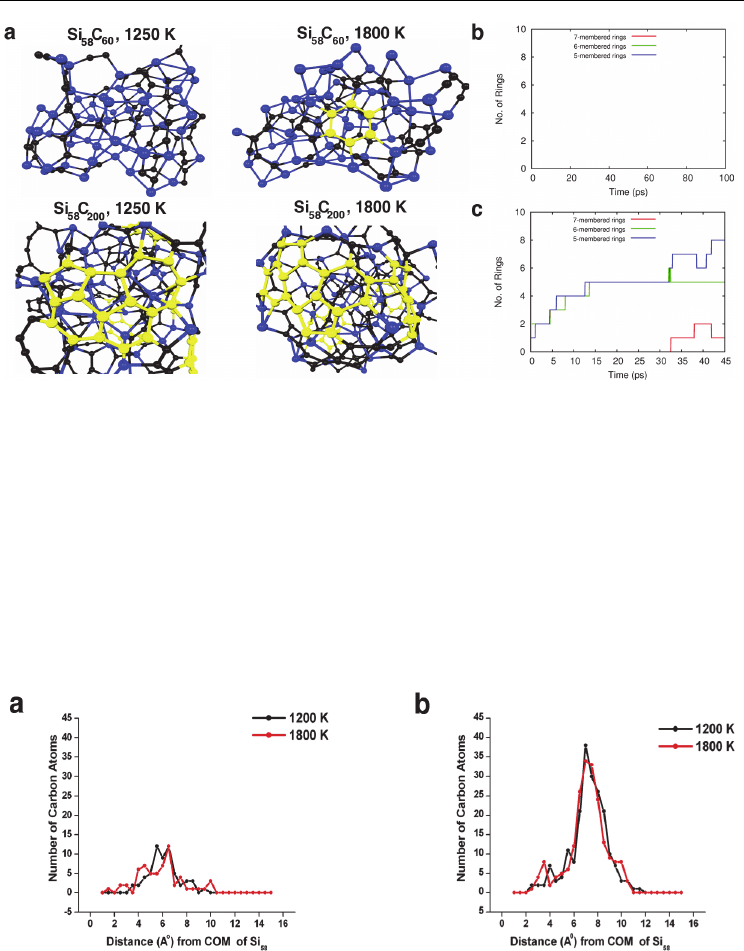
Mechanisms of Single-Walled Carbon Nanotube Nucleation,
Growth and Chirality-Control: Insights from QM/MD Simulations
537
Fig. 9. SWNT nucleation on Si catalyst nanoparticles following the adsorption of gas-phase
C
2
. a) Structures of Si
58
C
60
and Si
58
C
200
model complexes at 1200 and 1800 K. Color
conventions as in Fig. 8. b) Polygonal ring populations observed using low [C] conditions
(i.e. a Si
58
C
60
model system). c) Polygonal ring populations observed using high [C]
conditions (i.e. Si
58
C
200
model system). It is evident that the initial saturation of the Si catalyst
surface with carbon is necessary in order for SWNT nucleation to proceed.
Si
58
, the subsequent extension of the sp
2
-hybridised carbon network proceeded at a
significantly slower rate. Fig. 9a also illustrates the effect of surface carbon concentration on
SWNT nucleation. For example, the formation of polygonal carbon rings in the Si
58
C
60
complex (following the adsorption of 30 C
2
species) is limited to a single hexagonal ring
structure after 100 ps. Conversely, an extended network of carbon ring structures was
formed in the Si
58
C
200
model complex after only 50 ps. Thus, as was the case regarding SiO
2
Fig. 10. Radial distributions of carbon in a) Si
58
C
60
and b) Si
58
C
200
model complexes at 1200
and 1800 K. The inability of carbon to freely diffuse through the bulk region of the Si
nanoparticle is evident. Consequently, the majority of the carbon in both cases resides on the
nanoparticle surface, the latter of which is solid. SWNT nucleation cannot therefore proceed
via a VLS mechanism.

Electronic Properties of Carbon Nanotubes
538
catalyst nanoparticles, it is evident that the saturation of the Si nanoparticle surface with
carbon is also a prerequisite for SWNT nucleation in this case. In this sense then, SWNT
nucleation on SiO
2
and Si
58
seemingly proceeds via an identical route – this point will be
discussed at greater length below.
Following the adsorption of C
2
onto the Si
58
nanoparticle surface, the resultant surface
structure resembled an amorphous SiC phase, while the core of the Si nanoparticle remained
pristine. This is evident from Fig. 10a, which shows the radial distribution of carbon within
the Si nanoparticle as SWNT nucleation proceeds. This figure also shows that, at higher
temperature, the penetration of the Si nanoparticle by adsorbed carbon atoms becomes more
probable, and is independent of the surface carbon concentration. Yet, the free diffusion of
carbon through the nanoparticle bulk and surface in this case is restricted below 2000 K. The
latter observation may be explained with recourse to an analysis of the nanoparticle phase
during SWNT nucleation. This is conveniently done in the realm of QM/MD simulations via
the Lindemann index (Lindemann, 1910),
,
1
i
i
N
(6a)
where,
2
2
1
1
ij ij
T
T
i
ji
ij
T
rr
N
r
(6b)
Here, N is the number of atoms in the relevant system, r
ij
is the instantaneous distance
between atoms i and j, and the brackets denote thermal averaging over a finite interval of
time at temperature T. It is noted here that
describes all atoms in the system, and is thus
generally referred to as the ‘global’ Lindemann index. On the other hand,
i
pertains only to
the motion of atom i, and is therefore referred to as the ‘atomic’ Lindemann index. In the
current discussion, we will make reference to both
and
i
. The Lindemann index has
been used with particular success in the investigation of transition and main group metal
species (both bulk and nanoparticle structures) (Ding et al., 2006b; Puri & Yang, 2007; Neyts
& Bogaerts, 2009; Wen et al., 2009). From these investigations, the efficacy of the Lindemann
index in the prediction of nanoparticle melting points has been established. For example, it
is now generally accepted that the ‘threshold’
value, which signifies the transition
between the solid and liquid phases is between 0.10 – 0.15 (Ding et al., 2006b; Puri & Yang,
2007; Neyts & Bogaerts, 2009; Wen et al., 2009). Thus, any system exhibiting a
below this
threshold value may be considered to be solid, whereas those with
above this threshold
value are considered to be liquid. In the case of the pristine Si
58
catalyst nanoparticle,
at
1200 and 1800 K were 0.298 and 0.372, respectively. However, upon the adsorption of C
2
on
the Si
58
surface, a dramatic decrease in this Lindemann index was observed. At low carbon
concentrations (i.e. the Si
58
C
60
model complex), these same
values were 0.093 and 0.231,
while at high concentrations (i.e. the Si
58
C
200
model complex), they were 0.049 and 0.088,
respectively. This decrease indicates that the phase of the catalyst nanoparticle here changes
from a liquid (when pristine) to solid (when carbon-doped). This therefore makes SWNT

Mechanisms of Single-Walled Carbon Nanotube Nucleation,
Growth and Chirality-Control: Insights from QM/MD Simulations
539
nucleation via the VLS mechanism impossible. Considering this impasse, and the atomistic
similarity between SWNT nucleation from Si and SiO
2
nanoparticles, it is apparent that both
proceed via the VSS mechanism, as opposed to the VLS mechanism.
The production of an amorphous SiC nanoparticle following the adsorption of C
2
on Si
nanoparticles warranted the further investigation of the possibility of SWNT nucleation
from SiC itself. Moreover, following the conclusion discussed above, viz. that SWNT
nucleation on both SiO
2
and Si occur via identical pathways, it is reasonable to anticipate
that the same applies in the context of SiC. To this end, we have investigated nucleation of
SWNT cap fragments as a result of the constant temperature thermal annealing of SiC
nanoparticles alone. In this case, a model Si
96
C
96
nanoparticle was annealed between 1000
and 3000 K. An example of SWNT nucleation observed at 2500 K is illustrated in Fig. 11. It is
noted that this temperature is approximately that employed in relevant experiments which
demonstrate SWNT growth following the decomposition of SiC crystals (Kusunoki et al.,
1997). These QM/MD simulations indicated that SWNT nucleation in this case followed the
degradation of the SiC crystalline structure. Indeed, upon annealing even at temperatures as
low as 1000 K a well-defined crystallinity was not evident in the model SiC nanoparticle
even after a relatively short simulation time (i.e. 10-20 ps). The result of this degradation
was the disruption of C-Si bonds, in favor of C-C bonds, which exhibited free
diffusion through/over the SiC nanoparticle. This diffusion immediately lead to the
elongation/oligomerisation of these polyyne chains with high frequency. However, the
frequency of these interactions was concomitantly slower at lower temperatures, such as
1000 K. As is evident from Fig. 11a,b, polygonal ring formation followed the initial period in
which the oligomerisation of polyyne chains took place. In this case, the initial polygonal
ring formation was the result of the diffusion and subsequent interaction of neighboring C
3
and C
2
species. Fig. 11b shows that subsequent ring condensation then proceeded
reasonably rapidly, with a definite cap structure being formed within ca. 200 ps. However,
following the formation of this cap structure, the population of polygonal rings here then
decreased – such a phenomenon has not been observed in the case of traditional, transition
metal catalyst nanoparticles. In a kinetic sense, therefore, SWNT nucleation resulting from
thermal degradation of SiC is anticipated to be less favorable, compared to other traditional
catalysts. SWNT nucleation, at the atomic level, is essentially no more than the continual
formation of C-C bonds. The origin for these inhibited SWNT nucleation kinetics can
therefore be found in thermodynamics, which, at high temperatures, dominate SWNT
nucleation. In this sense then, SWNT nucleation is in effect a ‘thermodynamic sink’. From
§3.3, it is evident that thermal annealing of amorphous Fe- and Ni-carbide nanoparticles
yielded well-defined SWNT cap structures, similar to those observed here. However, SWNT
nucleation from Fe- and Ni-carbide nanoparticles also resulted in cap structures exceeding
the size of those observed using SiC, both on shorter timescales (generally within ca. 100 ps)
and at lower temperatures (below 2000 K). The strengths of the Fe-C, Ni-C and Si-C
interactions are 1.78, 1.06 and 6.29 eV/atom, respectively, at the SCC-DFTB level of theory
(Page et al., 2010d). Recall that the strength of the C-C interaction, using SCC-DFTB, is 9.14
eV/atom. The weaker interaction of the Fe/Ni catalyst with carbon therefore correlates
directly with an increased rate of SWNT nucleation. Once a C-C bond forms in the latter
case, it is rarely broken due to its greater thermodynamic stability (even if it is not the most
energetically stable ring structure). On the other hand, the Si-C and C-C interactions are,
thermodynamically, comparable to each other. Consequently, C-C bonds are more
frequently broken during nucleation on SiC nanoparticles.
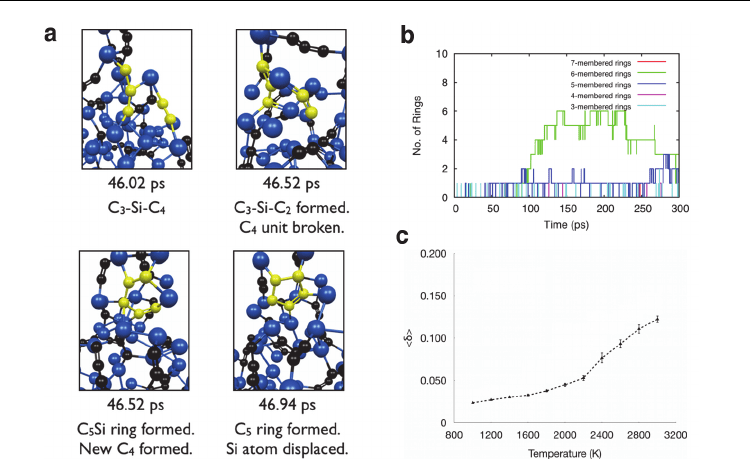
Electronic Properties of Carbon Nanotubes
540
Fig. 11. Thermal annealing at constant temperature (2500 K) leads to the structural
deformation of SiC nanoparticles, ultimately producing SWNT nucleation. a) The first
polygonal ring formation event due to the free diffusion of C
n
units within the SiC
nanoparticle. Color conventions as in Fig. 8. b) Polygonal ring formation formed from the
structural decomposition of the SiC nanoparticle at 2500 K. c) Time-averaged
values of
the SiC nanoparticle between 1000 – 3000 K, computed over an interval of 50 ps. SWNT
nucleation below 2600 K evidently occurs while the SiC nanoparticle is in the solid phase.
Thus, SWNT nucleation can be explained with recourse to a VSS mechanism.
The dependence of <
> on simulation temperature for the SiC nanoparticle are depicted in
Fig. 11c. From this figure it is evident that the SiC nanoparticle existed in the solid state
below 2600 K. However, Fig. 11c suggests that there was undoubtedly some liquid-like
character in the SiC nanoparticle at temperatures above 2600 K. In particular, <
i
> values
(not shown) indicate that, between 1000 and 3000 K, the SiC nanoparticle exhibited three
distinct behaviors depending on the temperature. Firstly, at lower temperatures (<1400 K)
the SiC nanoparticle were unquestionably solid. At intermediate temperatures (between
1400 – 2600 K) a gradual increase in <
i
> for atoms residing close, or near to, the
nanoparticle surface was evident. Surface premelting therefore became prevalent at these
temperatures, ultimately causing <
> to increase slightly. Such surface premelting has been
shown to be a prominent phenomenon in the melting dynamics of transition metal
nanoparticle species (Neyts & Bogaerts, 2009). In this respect therefore, transition metals and
SiC nanoparticles appear to be equivalent. According to established trends regarding
transition metal nanoparticle melting, by increasing the temperature further this surface
premelting is followed by the complete liquefaction of the nanoparticle. However, rather
than undergoing this solid-liquid phase transition, the SiC nanoparticle instead became
quasi-solid at temperatures above 2600 K. One probable cause of this unexpected behavior is

Mechanisms of Single-Walled Carbon Nanotube Nucleation,
Growth and Chirality-Control: Insights from QM/MD Simulations
541
ascribed to the influence of surface chemistry (viz. the formation of C-C bonds, polyyne
chains and polygonal carbon rings etc.) on the Lindemann index itself. In extreme cases, the
formation of an extended sp
2
-hybridised carbon network on the SiC nanoparticle surface, in
part, solidified the SiC nanoparticle surface, therefore retarding the melting process.
A pronounced similarity is therefore observed regarding the SWNT nucleation mechanisms
on SiO
2
, SiC and Si catalysts. The results discussed here constitute the first evidence of a
catalyst independent mechanism with respect to Si-based catalysts. In addition, these results
indicate the mechanism of SWNT nucleation on these Si-based catalysts is remarkably
different to that established for transition metal catalysts, and centres around a solid phase
catalyst nanoparticle. Since the independence of the SWNT nucleation mechanism has been
established and accepted in the case of transition metal catalysts, this conclusion is
seemingly unremarkable. However, we point out here that with respect to the majority of
‘non-traditional’ catalysts such as SiO
2
, SiC, Si, Al
2
O
3
, ZrO
2
, and so on, the precise
mechanisms of SWNT nucleation remains are in fact unknown at present. Moreover, at first
glance there is no reason to suspect that the SWNT nucleation mechanism on such a diverse
range of catalyst species should be in any way related, considering their respective
physicochemical properties.
4. QM/MD simulations of SWNT growth
We now consider the phenomenon of continued SWNT growth. This is generally defined as
the extension of the nanotube sidewall (by the addition of newly created polygonal ring
structures) parallel to the axis of growth. Note that this process differs from the process of
SWNT nucleation, in which the nascent nanotube cap-fragment is formed. This partitioning
of what is actually (in reality) a continuous process is somewhat arbitrary. Nonetheless, it
has enabled the precise atomistic mechanism of SWNT growth to be identified and studied.
4.1 SWNT growth on Fe catalysts
Continued SWNT growth has been modeled using QM/MD simulations on a number of
occasions (see (Page et al., 2010c) and references therein). The approach employed in these
investigations typically was similar to that described in §3.2 (see Fig. 12). Fe-catalyst
nanoparticles were thus first annealed at 1500 K, after which ‘simulated’ gas-phase carbon
feedstock (in this case, C or C
2
) was adsorbed at various rates at the base of the growing
SWNT, or onto the nanoparticle surface itself. Two such nanoparticles have been employed,
viz. Fe
38
and Fe
55
. In both cases, a model SWNT cap fragment (a C
40
cap of (5,5) chirality), or
short SWNT segment (depicted in Fig. 12) were employed to approximate a SWNT cap
fragment formed in situ (such as that shown in Fig. 4). The effect of the nanoparticle
diameter on the mechanism and kinetics of continued SWNT growth has therefore been
elucidated. Somewhat unsurprisingly, the increase in nanoparticle diameter from 0.70 nm
(Fe
38
) to 0.94 nm (Fe
55
) has no effect on the atomistic mechanism of continued SWNT
growth. This mechanism is depicted in Fig. 12. From this figure it is evident that, like SWNT
nucleation, the continued SWNT growth process was driven by the extension of the sp
2
-
hybridised carbon network. This extension itself was driven by the formation of polygonal
carbon rings at the base of the nanotube structure (at the interface between the nanotube
and the catalyst nanoparticle), thereby extending the SWNT cap in a unidirectional manner.
From Fig. 12 it can be seen that the SWNT growth process took place almost entirely on the
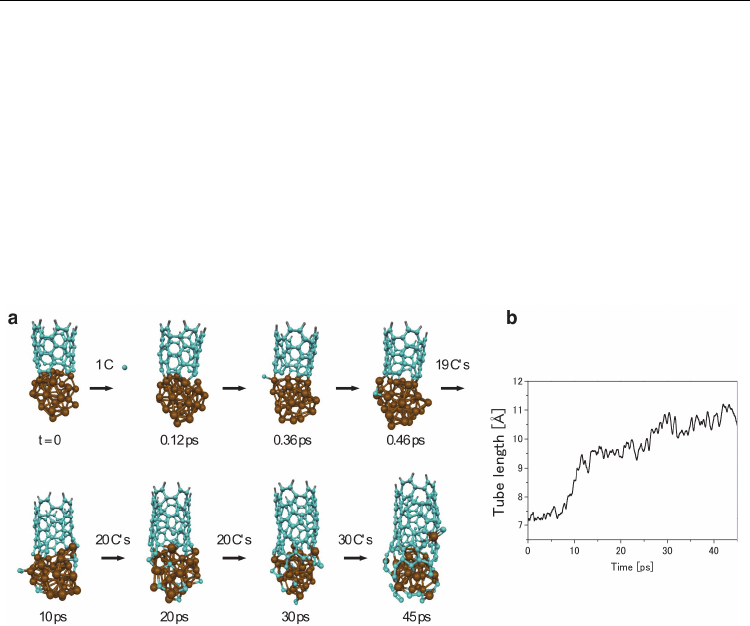
Electronic Properties of Carbon Nanotubes
542
catalyst surface. Only very rarely did carbon penetrate the catalyst surface and diffuse
through the subsurface region. Similarly, carbon was never observed to freely diffuse
through the bulk of the catalyst nanoparticle. Unsurprisingly, this behavior was no different
from the behavior observed during SWNT nucleation on Fe
38
, a fact that is attributed to the
nanoparticles relatively small diameter, and consequently relatively high surface energy. It
is also noted here that Fe
38
and Fe
55
are both ‘magic number’ metal clusters, and so exhibit
unusual stability compared to other nanoparticles of comparable diameter. The SWNT
growth depicted in Fig. 12 is an example growth from a ‘floating’ catalyst (most similar to
that observed during pure VLS processes, such as arc-discharge). However, it is likely that
the mechanism of SWNT ‘root’/’tip’ growth on supported catalyst nanoparticles is similar
to that depicted in Fig. 12, since the majority of SWNT growth chemistry is mediated by the
nanoparticle surface itself.
Fig. 12. Continued SWNT growth from a (5,5) SWNT fragment on an Fe
38
catalyst
nanoparticle at 1500 K. a) The adsorption of gas-phase carbon atoms at a rate of 1 C / 0.5 ps
at the base of the SWNT structure leads to the extension of the sp
2
-hybridised carbon
network via the formation of new polygonal rings at the SWNT base. Growth is mediated
entirely by the catalyst surface in this case. Color conventions as in Fig. 1. b) The SWNT
length as a function of time at 1500 K. Adsorption of gas-phase carbon atoms results in the
addition of ca. 4 Å to the base of the SWNT. (Adapted from (Ohta et al., 2008). Reprinted
with permission. © 2008 American Chemical Society)
While the SWNT growth mechanisms on Fe
38
and Fe
55
were observed to be the same, this is
not so with respect to the kinetics of SWNT growth. QM/MD simulations (Page et al., 2010b)
indicate that SWNT growth slows with increasing catalyst nanoparticle diameter – a
conclusion that parallels others based on experimental evidence (Huang et al., 2002; Cau et
al., 2006; Mora & Harutyunyan, 2008). This phenomenon is ascribed primarily to the relative
surface areas and volumes of the two catalyst nanoparticles. In particular, although the
diameter of Fe
55
is only slightly larger than that of Fe
38
, the increases in surface area and
volume are more substantial. Thus, the domain over/through which adsorbed C
n
species
may migrate, before being incorporated into the growing SWNT, is concomitantly larger in
the case of Fe
55
. SWNT growth employing the former, smaller catalyst nanoparticle is
therefore ca. 19% faster compared to that on Fe
55
. It is conceded that both of these growth

Mechanisms of Single-Walled Carbon Nanotube Nucleation,
Growth and Chirality-Control: Insights from QM/MD Simulations
543
rates exceed those determined experimentally (Puretzky et al., 2002; Futaba et al., 2005;
Sharma et al., 2005; Geohegan et al., 2007; Yao et al., 2007; Xiang et al., 2009) by several orders
of magnitude. This is a natural consequence of the relatively unnatural carbon adsorption
model that has been employed here. Nevertheless, the error thus induced is systematic, and
so these relative trends in growth rates remain valid.
4.2 The importance of interaction energy: Ni versus Fe catalysts
The fact that different SWNT catalyst materials yield different SWNT growth rates has been
established experimentally on numerous occasions (Puretzky et al., 2002; Futaba et al., 2005;
Sharma et al., 2005; Geohegan et al., 2007; Yao et al., 2007; Xiang et al., 2009). Nevertheless, no
clue was gained as to why this was the case until recently. QM/MD simulations (Page et al.,
2010a; Page et al., 2010b) again proved to be of value in this respect, and established the
single origin of catalyst-dependent SWNT growth kinetics.
QM/MD simulations of Ni
38
-catalysed growth from a C
40
SWNT cap fragment are
summarised in Fig. 13a. Fig. 13b shows a comparison of Fe
55
- and Ni
55
-catalysed SWNT
growth rates. Once again, in all cases growth was induced by the adsorption of gas-phase
carbon atoms at the base of the C
40
SWNT cap structure at a rate of 1 C /0.5 ps. Comparison
of Fig. 12a and 13a shows that the mechanism of SWNT growth, at the atomistic scale,
exhibits significant differences. Most notably in this respect is the role of the extended
polyyne chains which bridge between the SWNT base and the catalyst surface. In the case of
Fe
38
(Fig. 12a), these chains generally consisted of 3-4 carbon atoms, and were formed as
individual C/C
2
species diffused across the Fe
38
surface towards the SWNT base. On the
other hand, Fig. 13a shows that the polyyne chains bridging between the SWNT base and
the catalyst surface in the case of Ni
38
were far greater in length. Generally, such polyyne
chains were observed to be as large as C
10
for Ni
38
and Ni
55
catalyst nanoparticles. In both
Fe- and Ni-catalyst cases, continued SWNT growth was driven by the formation of
polygonal carbon rings at the base of the SWNT, generally from the interaction of these
bridging carbon chains. The length of these carbon chains therefore proved to be a critical
factor in the context of the SWNT growth mechanism. For Ni
38
and Ni
55
catalysts, the rate of
extension of these carbon chains was greater than the rate at which they self-isomerised, or
‘collapsed’ (Page et al., 2010a). In the case depicted in Fig. 13a, the extension and collapse of
a single polyyne chain bound to the base of the growing C
40
cap structure resulted in the
formation of a conjugated 6-5-7-5 carbon ring system. Conversely, the rates of polyyne
extension and collapse observed using Fe
38
and Fe
55
catalyst nanoparticles were generally
more equivalent. SWNT growth was thus limited by the rate of polyyne chain extension.
Ultimately these mechanistic differences yield Ni-catalysed SWNT growth rates ca. 69 –
106% greater than those found using Fe-catalysed, for equivalent catalyst nanoparticle size.
Somewhat unsurprisingly, the fundamental factor explaining the kinetic differences of Fe-
and Ni-catalysed SWNT growth are the same as those which explain the differences in Fe-
and Ni-catalysed SWNT nucleation. Fig. 12a and 13a show that, once again, the relative
strengths of the Fe-C, Ni-C and C-C interactions correlate exactly with the observed SWNT
nucleation kinetics. For example, the rate of SWNT growth is limited by the rate at which
the bridging polyyne chains (pictured in Fig. 12a and 13a) can incorporate new carbon. This
rate, in turn, is determined by the relative thermodynamics of C-C bond formation in the
presence of Fe and Ni atoms. As was discussed in §3.3, the relative weakness of the Ni-C
interaction means that, in a thermodynamic sense, the formation of C-C bonds on Ni-
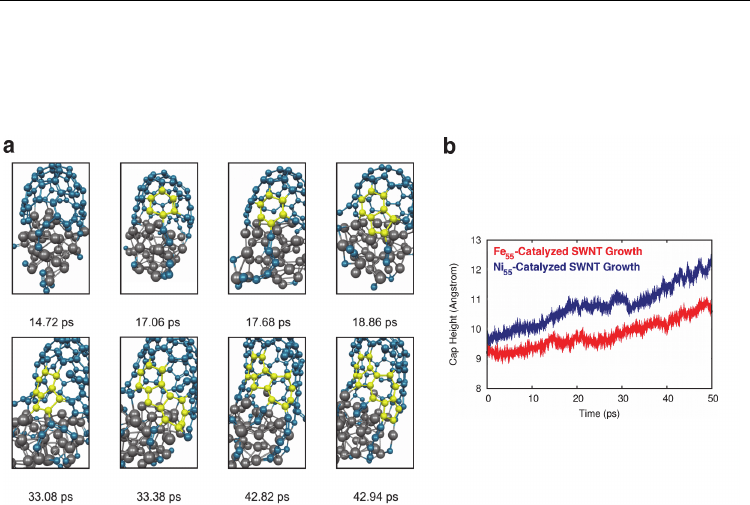
Electronic Properties of Carbon Nanotubes
544
catalysts is a more favorable process compared to that on Fe-catalysts. In this sense,
therefore, the strength of the catalyst-carbon interaction constitutes a fundamental, guiding
principle for understanding the mechanisms and kinetics of SWNT growth on different
catalyst materials.
Fig. 13. Continued SWNT growth from a (5,5) C
40
SWNT cap on a Ni
38
catalyst nanoparticle
at 1500 K. a) In this case, the extension and collapse of a single bridging polyyne chain
results in the formation of an extended conjugated system at the base of the SWNT,
including a hexagonal, heptagonal and two pentagonal carbon rings. Color conventions as
in Fig. 6. b) Depending on the size of the catalyst nanoparticle, Ni-catalysed SWNT growth
is found to be ca. 69 – 106% faster than Fe-catalysed SWNT growth at 1500 K. (Adapted from
(Page et al., 2010a). Reprinted with permission. © 2010 American Chemical Society)
5. SWNT defects, healing and chirality-controlled growth
As has been shown in §2 – 4, there have been significant advances in both experimental and
theoretical understanding of SWNT nucleation and growth on a number of different catalyst
species. Yet there are still outstanding issues regarding phenomena associated with SWNT
growth. The most notable phenomenon at present is that of ‘chirality-controlled’ growth.
That is, a method by which a single particular (n, m) chirality SWNT (or, at most a narrow
distribution of (n, m) SWNTs) may be synthesised in situ remains elusive to date. At the
atomistic scale, chirality-controlled growth equates to growth in which only hexagonal rings
are incorporated into the growth SWNT structure. The fundamental principles guiding such
chirality-specific synthesis are, as yet, largely unknown. Such chirality-controlled growth is
extremely desirable, since the physical, electrical and optical properties of a SWNT are
determined entirely by its (n, m) chiral indices. Current experimental SWNT synthesis
techniques (such as CVD and arc-discharge) are known to produce a broad distribution of
(n, m) SWNTs. While it is possible to subsequently isolate a narrow distribution of (n, m)
SWNTs, such techniques invariably damage the SWNT structures by either chemical or
physical means (Li et al., 2007; Zheng & Semke, 2007). Such damage potentially limits the
